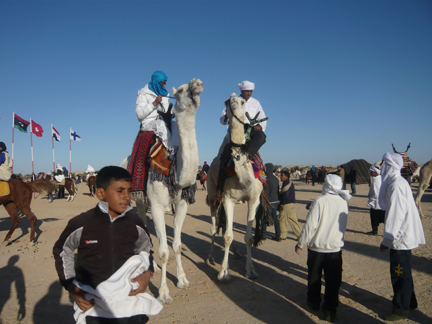
Mahri camels at the International Festival of the Sahara in Douz, Tunisia,
December 24, 2012. Photo by Sam Liebhaber.
by Sam Liebhaber
One of the long-standing myths of Berber ancestry places their origins in Yemen from whence they were dispatched to North Africa in the service of ancient Ḥimyarite kings. Although this chapter in the mythological prehistory of the Arab world can be refuted on the grounds that the Berber are indisputably indigenous to North Africa, the offhand dismissal of the South Arabian-Berber imaginary overlooks an important sociolinguistic kinship between the Berber of North Africa and one of the last indigenous linguistic communities of the Arabian Peninsula: the Mahra of Yemen and Oman.
A number of socio-cultural parallels distinguish the Berber and Mahra from the other minority language communities of the Middle East. For one, the Mahra and Berber are members of the Islamic ʾummah, unlike many of the other minority language communities of the Arab world where linguistic boundaries are frequently coterminous with religious divisions. Further, the Berber and the Mahra did not inherit a written tradition that includes religious and literary texts. As a consequence, the Mahri and Berber languages are frequently consigned to the category of “lahja,†an Arabic term that signifies any non-prestigious, vernacular idiom that lacks of historical or social value.
Without their own written history or affiliation to a prestigious, non-Arab civilization, the Mahra and Berber are more easily “willed†into historical narratives of “Arabness†(Ê¿urÅ«ba) than the other language minority communities of the Arab world. This motif is the mainstay of modern Arabic scholarship on Berber and Mahri genealogical and language origins. A sample of a few recent titles demonstrates this point: The Berber: Ancient Arabs (al-Barbar: Ê¿Arab qudÄmÄ, al-Ê¿ArbÄwÄ«, Tunis: 2000), The Arabness of the Berber: The Hidden Truth (Ê¿UrÅ«bat al-Barbar: al-ḤaqÄ«qa al-MaghmÅ«ra, MÄdÅ«n, Damascus: 1992), Comprehension of Arabic and the Secret of the Mahri Language (Fiqh al-Ê¿Arabiyya wa-sirr al-lugha al-mahriyya, al-Ways, Sana’a: 2004) and Ancient Arabic and its Dialects (ie, Mahri, al-Ê¿Arabiyya al-qadÄ«ma wa-lahajÄtuhÄ, MÄrÄ«kh, Abu Dhabi: 2000).
Even if contemporary scholarship on Mahri and Berber origins is problematic, it is conceivable that historical intersections between the Berber and the Mahra gave medieval Arab historians a justifiable basis to propose their common ancestry. Ibn Ê¿Abd al-Ḥakam’s (d. 870 CE) History of the Conquest of Egypt and Its Events (Futūḥ Maá¹£r wa-ʾakhbÄruhÄ) makes it clear that Mahri soldiers played an outsized role in the Arab-Islamic conquests of Egypt and North Africa. In addition to being commended by Ê¿Amr ibn al-ʿĀṣ for fighting in the vanguard during the siege of Alexandria (“The Mahra are a tribe that kills, but are not killedâ€), the first Arab-Islamic military incursion into Libya was undertaken by a Mahri commander, Ê¿Abd al-SallÄm ibn HabÄ«ra al-Mahri, who was subsequently appointed governor of the Libyan province of Burqa. As the Umayyad Caliphate turned its sights further westwards, six hundred Mahri soldiers were dispatched to “IfrÄ«qiya†(modern-day Tunisia) under the command of Ê¿AbdullÄh ibn SaÊ¿d ibn Sarḥ. In Libya and IfrÄ«qiya, the native Berber-speaking populations would have had ample opportunity to interact with “Arab†troops from al-Mahra whose native language was not Arabic.
The historical record of the Mahra as a distinct entity fades as the Mahra moved west across North Africa. However, the persistence of the mahrÄ« (pl. mahÄrÄ«) camel of North Africa bespeaks the impact that the Mahra had on the indigenous population. In particular, the mahrÄ« camels are the prize possession of the Touareg nomads, a Berber (Tamashek) speaking tribe of the Senhaja confederation of whom even the skeptic Ibn KhaldÅ«n imputes a “Ḥimyari†lineage. Disregarding the notion that the Senhaja Berber are in any way descended from ancient Yemenis, it is possible that the South Arabian lineage of the mahrÄ« camel was projected onto the Touareg, whose lives are so deeply intertwined with their camel-stock. Concerning the deeply personal bond between the Touareg and their mahÄris, the Libyan novelist Ibrahim al-Koni writes:
We always say that the Mahri is the mirror of his rider. If you want to stare into the rider and see what lies hidden within, look to his mount, his [Mahri] . . . Whoever owns a Mahri like this piebald will never complain for want of noble values.
(Ibrahim al-Koni, Gold Dust, trans. Elliott Colla [London: Arabia Books, 2008], 15)
From the perspective of the South Arabian-Berber imaginary, it might be more accurate to say that the Touareg is the mirror of his Mahri.
Samuel Liebhaber is Assistant Professor of Arabic and International Studies at Middlebury College
(slieb@middlebury.edu)
Based on the talk, “South Arabia and the Amazigh Imaginary,†given at “The Berber Symposium: Language, Culture and Society in Tunisia and Beyond,†Centre d’Etudes MaghreÌbines a Tunis, March 6, 2012.